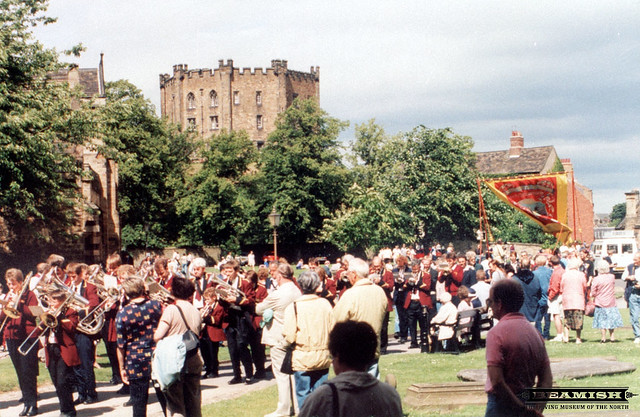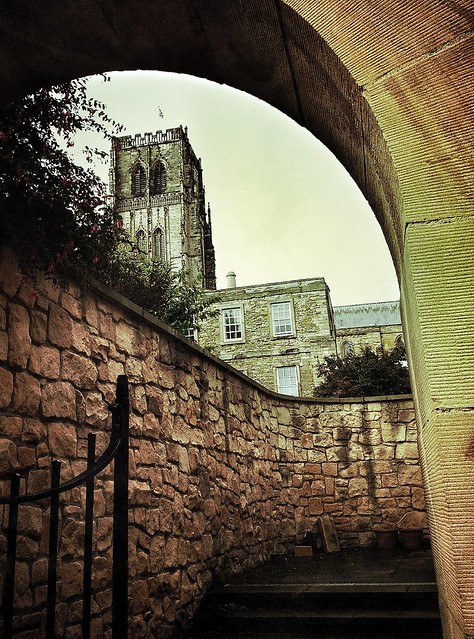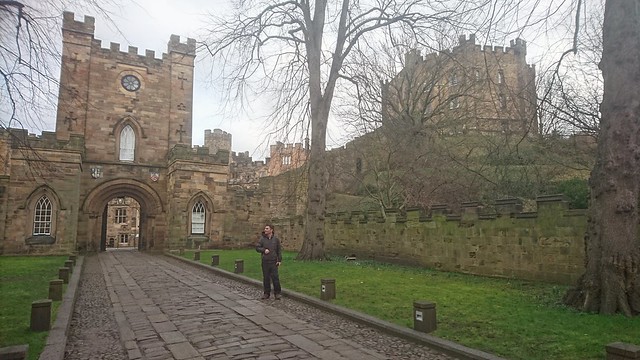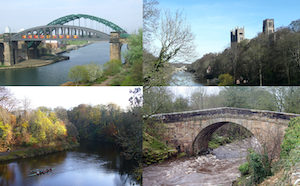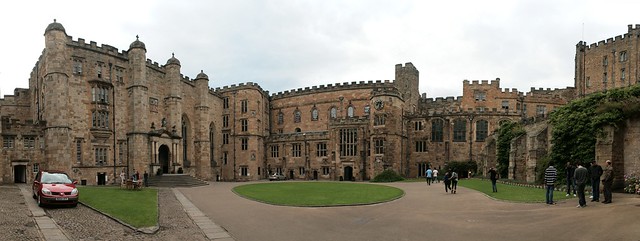Topics > County Durham > Durham (City)
Durham (City)
Early history
Archeological evidence suggests a history of settlement in the area since roughly 2000 BC. The present city can clearly be traced back to AD 995, when a group of monks from Lindisfarne chose the strategic high peninsula as a place to settle with the body of Saint Cuthbert, that had previously lain in Chester-le-Street, founding a church there.
Legend of the Dun Cow and city origins
Local legend states that the city was founded in A.D. 995 by divine intervention. The 12th century chronicler Symeon of Durham recounts that after wandering in the north, Saint Cuthbert's bier miraculously came to a halt at the hill of Warden Law and, despite the effort of the congregation, would not move. Aldhun, Bishop of Chester-le-Street and leader of the order, decreed a holy fast of three days, accompanied by prayers to the saint. During the fast, Saint Cuthbert appeared to a certain monk named Eadmer, with instructions that the coffin should be taken to Dun Holm. After Eadmer's revelation, Aldhun found that he was able to move the bier, but did not know where Dun Holm was.
The legend of the Dun Cow, which is first documented in The Rites of Durham, an anonymous account about the Durham Cathedral, published in 1593, builds on Symeon's account. According to this legend, by chance later that day, the monks came across a milkmaid at Mount Joy (southeast of present-day Durham). She stated that she was seeking her lost dun cow, which she had last seen at Dun Holm. The monks, realising that this was a sign from the saint, followed her. They settled at a wooded "hill-island" – a high wooded rock surrounded on three sides by the River Wear. There they erected a shelter for the relics, on the spot where the Durham Cathedral would later stand. Symeon states that a modest wooden building erected there shortly later was the first building in the city. Bishop Aldhun subsequently had a stone church built, which was dedicated in September 998. It no longer remains, having been supplanted by the Norman structure.
The legend is interpreted by a Victorian relief stone carving on the south face of the cathedral and, more recently, by the bronze sculpture 'Durham Cow' (1997, Andrew Burton), which reclines by the River Wear in view of the cathedral.
Medieval history
During the medieval period the city gained spiritual prominence as the final resting place of Saint Cuthbert and Saint Bede the Venerable. The shrine of Saint Cuthbert, situated behind the High Altar of Durham Cathedral, was the most important religious site in England until the martyrdom of St Thomas Becket at Canterbury in 1170.
Saint Cuthbert became famed for two reasons. Firstly, the miraculous healing powers he had displayed in life continued after his death, with many stories of those visiting the saint's shrine being cured of all manner of diseases. This led to him being known as the "wonder worker of England". Secondly, after the first translation of his relics in 698 AD, his body was found to be incorruptible. Apart from a brief translation back to Holy Island during the Norman Invasion the saint's relics have remained enshrined to the present day. Saint Bede's bones are also entombed in the cathedral, and these also drew medieval pilgrims to the city.
Durham's geographical position has always given it an important place in the defence of England against the Scots. The city played an important part in the defence of the north, and Durham Castle is the only Norman castle keep never to have suffered a breach. The Battle of Neville's Cross, which took place near the city on 17 October 1346 between the English and Scots, is the most famous battle of the age.
The city suffered from plague outbreaks in 1544, 1589 and 1598.
Prince Bishops
Owing to the divine providence evidenced in the city's legendary founding, the Bishop of Durham has always enjoyed the title "Bishop by Divine Providence" as opposed to other bishops, who are "Bishop by Divine Permission". However, as the north-east of England lay so far from Westminster, the bishops of Durham enjoyed extraordinary powers such as the ability to hold their own parliament, raise their own armies, appoint their own sheriffs and Justices, administer their own laws, levy taxes and customs duties, create fairs and markets, issue charters, salvage shipwrecks, collect revenue from mines, administer the forests and mint their own coins. So far-reaching were the bishop's powers that the steward of Bishop Antony Bek commented in 1299 AD: "There are two kings in England, namely the Lord King of England, wearing a crown in sign of his regality and the Lord Bishop of Durham wearing a mitre in place of a crown, in sign of his regality in the diocese of Durham". All this activity was administered from the castle and buildings surrounding the Palace Green. Many of the original buildings associated with these functions of the county palatine survive on the peninsula.
Every Bishop of Durham from 1071 to 1836 was a Prince Bishop except for the first Norman appointment, Bishop Walcher (in office ca. 1071-1080), who was styled an Earl-Bishop. Although the term "prince bishop" has been used as a helpful tool in the understanding the functions of the Bishops of Durham it is not a title they would have recognised. The last Prince Bishop of Durham, Bishop William Van Mildert, is credited with the foundation of Durham University in 1832. Henry VIII curtailed some of the Prince-Bishop's powers and, in 1538, ordered the destruction of the shrine of Saint Cuthbert.
Legal system
The Prince Bishops also had their own court system, most notably the Court of Chancery of the County Palatine of Durham and Sadberge. The county also had its own attorney general, whose authority to bring an indictment for criminal matters was tested by central government in the case of R v Mary Ann Cotton (1873). Certain courts and judicial posts for the county were abolished by the Supreme Court of Judicature Act 1873.
Others were abolished by section 2 of the Durham (County Palatine) Act 1836 and section 41 of the Courts Act 1971.
Civil War and Commonwealth (1640 to 1660)
The city remained loyal to King Charles I throughout the English Civil War. Charles I came to Durham twice during his reign. Firstly, he came to the cathedral for a majestic service in which he was entertained by the Chapter and Bishop at great expense at the start of his reign. His second visitation to the city came towards the end of the civil war, escaping from the city as Oliver Cromwell's forces got closer. Local legend
stated he escaped down the Bailey and through Old Elvet. Another local legend has it that Cromwell stayed in a room in the present Royal County Hotel on Old Elvet during the civil war. The room is reputed to be haunted by his ghost. Durham suffered greatly during the civil war and Commonwealth. This was not due to direct assault by Cromwell but the abolition of the Church of England and the closure of religious institutions pertaining to it. The city has always relied upon the Dean and Chapter and cathedral as an economic force.
The castle suffered considerable damage and dilapidation during the Commonwealth due to the abolition of the office of bishop whose residence it was. Cromwell confiscated the castle and sold it to the Lord Mayor of London shortly after taking it from the bishop. A similar fate befell the cathedral, it being closed in 1650 and used to incarcerate 3,000 Scottish prisoners. Graffiti left by them can still be seen today etched into the interior stone.
At the Restoration in 1660, John Cosin (a former canon) was appointed bishop and set about a major restoration project. This included the commissioning of the famous elaborate woodwork in the cathedral choir, the font cover and the Black Staircase in the castle. Other renovations were carried out to both the city and cathedral by his successor Bishop Lord Nathaniel Crewe.
18th century
In 1720 it was proposed that Durham could become a sea port by digging a canal north to join the River Team, a tributary of the River Tyne near Gateshead. Nothing came of the plan, but the statue of Neptune in the Market Place was a constant reminder of Durham's maritime possibilities.
The thought of ships docking at the Sands or Millburngate remained fresh in the minds of Durham businessmen. In 1759, a new proposal hoped to make the Wear navigable from Durham to Sunderland by altering the river's course, but the increasing size of ships made this impractical. This was further compounded by the fact Sunderland had grown as the north east's main port and centre for shipping.
The 18th century also saw the rise of the trade union movement in the city.
19th century
The Great Reform Act 1832 saw the removal of the Prince Bishop's powers, although he still has the right to a seat in the House of Lords and is regarded as the second most senior bishop and fourth most senior clergyman in the Church of England. The Court of Claims of 1953 granted the traditional right of the bishop to accompany the sovereign at the coronation, reflecting his seniority.
The first census, conducted in 1801, states that Durham City had a population of 7,100. The Industrial Revolution mostly passed the city by. However, the city was well known for carpet making and weaving. Although most of the mediaeval weavers who thrived in the city had left by the 19th century, the city was the home of Hugh MacKay Carpets’ factory, which produced the famous brands of axminster and tufted carpets until the factory went into administration in April 2005. Other important industries were the manufacture of mustard and coal extraction.
The Industrial Revolution also placed the city at the heart of the coalfields, the county's main industry until the 1970s. Practically every village around the city had a coal mine and, although these have since disappeared as part of the regional decline in heavy industry, the traditions, heritage and community spirit are still evident. The city also saw the creation of the world's first passenger railway in 1825.
The 19th century also saw the founding of Durham University thanks to the benevolence of Bishop William Van Mildert and the Chapter in 1832. Durham Castle became the first college (University College, Durham) and the bishop moved to Auckland Castle as his only residence in the county.
The first Durham Miners' Gala was attended by 5,000 miners in 1871 in Wharton Park, and remains the largest socialist trade union event in the world.
20th Century
During the 20th century the University expanded greatly. St John's College and St Cuthbert's Society were founded on the Bailey, completing the series of colleges in that area of the city. From the early 1950s to early 1970s Trevelyan, Van Mildert, Collingwood and Grey colleges were established to the south of the city, adjacent to new buildings for St Aidan's and St Mary's colleges for women, formerly housed on the Bailey. The final 20th century collegiate addition came from the merger of the independent nineteenth-century colleges of the Venerable Bede and St Hild, which joined the university in 1979 as the College of St Hild and St Bede. Other significant university expansions at this time include the Elvet Riverside and Dunelm House buildings on New Elvet, the building of the Maiden Castle sports complex adjacent to the Iron Age fort of the same name, and the development of what would become the university's main science buildings on South Road, beginning in 1924.
During World War II it was believed Durham might have become a target for the Baedeker raids, German attacks on historic British cities as retaliation for the bombing of Lübeck. On the 29th April/ 1 May 1942 the Luftwaffe did indeed enter County Durham and may have been targeting the city, although what actually happened on that night has become something of a local legend. One account is that a mist, descending over the City like a ghostly shroud, hiding every building, as if they had disappeared', created by St Cuthbert, obscured the city sufficiently that the German bombers could not complete their task. Later it was linked to a tale recounted by Symeon of Durham regarding a similar mist sent by Cuthbert to thwart William the Conqueror, adding legitimacy to the tale for those who believed it. However it was noted by the chief ARP warden on duty that night that mist is common in Durham, often rising from the river, and that it failed to cover the cathedral's central tower that night. Regardless of its truth the legend has continued to feature in the folklore of the city, including inspiring the artwork 'Fogscape #03238' at Durham Lumiere 2015.
Durham was created a UNESCO World Heritage Site in 1986, under the title 'Durham Castle and Cathedral'. Among the reasons given for the decision were 'Durham Cathedral [being] the largest and most perfect monument of "Norman" style architecture in England', and the cathedral's vaulting being an early and experimental model of the gothic style.
Visit the page: Durham, England for references and further details. You can contribute to this article on Wikipedia.

from Newcastle University (youtube)
County Durham Aka Cycle Meet At Durham (1939)
Pinned by Simon Cotterill

from Newcastle University (youtube)
Elizabeth Lays Foundation Stone (1947)
Pinned by Simon Cotterill

from Flickr (flickr)
snow -- Durham City Riverbanks -- Sat 27 Nov 2010 01-52-58 PM GMT.jpg
Pinned by Simon Cotterill

from https://openlibrary.org/works…
Durham protestations: The returns made to the House of Commons in 1641/2 for the maintenance of the Protestant religion for the county palatine of Durham, for the borough of Berwick-upon-Tweed and the parish of Morpeth.
- Digitised version of the book first published 1922 the Surtees Society by Andrews & Co. and, B. Quaritch, ltd. in Durham, London . eBook in a variety of formats or …
Added by
Simon Cotterill

Co-Curate Page
Battle of Neville's Cross, 1346
- Overview About the Battle The Battle of Neville's Cross took place close to Durham on 17 October 1346. King David II of Scotland invaded the north of England, whilst most …

Co-Curate Page
Crook Hall
- Overview Map Street View Crook Hall is a medieval manor house located in the Framwelgate area of Durham City. The oldest part of Crook Hall was built in the 14th …

from Flickr (flickr)
And now I'm #in @DurhamCouncil via @Virgin_TrainsEC @VirginTrains to #London :)
Pinned by Simon Cotterill

Co-Curate Page
Wharton Park
- Overview Map Street View Wharton Park is a public park situated immediately south of the Railway Station in Durham. The park was created in 1857, by William Lloyd Wharton (1789-1867) …

from Flickr (flickr)
Ancient Residence of the Earls of Westmoreland in the city of Durham.
Pinned by Simon Cotterill

from Flickr (flickr)
Image taken from page 469 of 'The Local Historian's Table Book of remarkable occurrences, historical facts, traditions, legendary and descriptive ballads, connected with the Counties of Newcastle-upon-Tyne, Northumberland, and Durham. Historical Division.
Pinned by Simon Cotterill

from Flickr (flickr)
Image taken from page 507 of 'The Local Historian's Table Book of remarkable occurrences, historical facts, traditions, legendary and descriptive ballads, connected with the Counties of Newcastle-upon-Tyne, Northumberland, and Durham. Historical Division.
Pinned by Simon Cotterill

from Flickr (flickr)
Image taken from page 205 of 'Comprehensive Guide to the County of Durham. With maps and plans'
Pinned by Peter Smith

from Flickr (flickr)
The Cathedral From River Wear, DURHAM, County Durham Arthur Payne
Pinned by Peter Smith

from Youtube (youtube)
Miner's Production Banner will honour productivity (1949)
Pinned by Simon Cotterill


from Newcastle University (youtube)
County Durham Aka Cycle Meet At Durham (1939)
Pinned by Simon Cotterill

from Newcastle University (youtube)
Elizabeth Lays Foundation Stone (1947)
Pinned by Simon Cotterill

from Flickr (flickr)
snow -- Durham City Riverbanks -- Sat 27 Nov 2010 01-52-58 PM GMT.jpg
Pinned by Simon Cotterill

from https://openlibrary.org/works…
Durham protestations: The returns made to the House of Commons in 1641/2 for the maintenance of the Protestant religion for the county palatine of Durham, for the borough of Berwick-upon-Tweed and the parish of Morpeth.
- Digitised version of the book first published 1922 the Surtees Society by Andrews & Co. and, B. Quaritch, ltd. in Durham, London . eBook in a variety of formats or …
Added by
Simon Cotterill

Co-Curate Page
Battle of Neville's Cross, 1346
- Overview About the Battle The Battle of Neville's Cross took place close to Durham on 17 October 1346. King David II of Scotland invaded the north of England, whilst most …

Co-Curate Page
Crook Hall
- Overview Map Street View Crook Hall is a medieval manor house located in the Framwelgate area of Durham City. The oldest part of Crook Hall was built in the 14th …

from Flickr (flickr)
And now I'm #in @DurhamCouncil via @Virgin_TrainsEC @VirginTrains to #London :)
Pinned by Simon Cotterill

Co-Curate Page
Wharton Park
- Overview Map Street View Wharton Park is a public park situated immediately south of the Railway Station in Durham. The park was created in 1857, by William Lloyd Wharton (1789-1867) …

from Flickr (flickr)
Ancient Residence of the Earls of Westmoreland in the city of Durham.
Pinned by Simon Cotterill

from Flickr (flickr)
Image taken from page 469 of 'The Local Historian's Table Book of remarkable occurrences, historical facts, traditions, legendary and descriptive ballads, connected with the Counties of Newcastle-upon-Tyne, Northumberland, and Durham. Historical Division.
Pinned by Simon Cotterill

from Flickr (flickr)
Image taken from page 507 of 'The Local Historian's Table Book of remarkable occurrences, historical facts, traditions, legendary and descriptive ballads, connected with the Counties of Newcastle-upon-Tyne, Northumberland, and Durham. Historical Division.
Pinned by Simon Cotterill

from Flickr (flickr)
Image taken from page 205 of 'Comprehensive Guide to the County of Durham. With maps and plans'
Pinned by Peter Smith

from Flickr (flickr)
The Cathedral From River Wear, DURHAM, County Durham Arthur Payne
Pinned by Peter Smith

from Youtube (youtube)
Miner's Production Banner will honour productivity (1949)
Pinned by Simon Cotterill

County Durham

Bow Lane, Durham

Church of St Oswald, Durham

Claypath, Durham

Crossgate, Durham
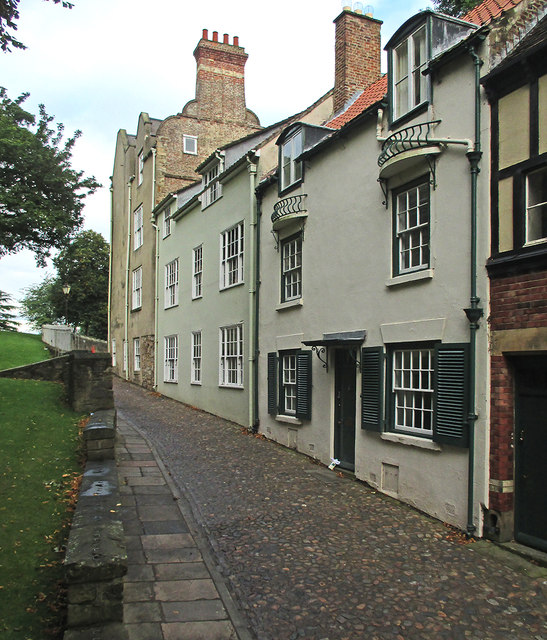
Dun Cow Lane, Durham

Durham at War

Durham Castle

Durham Cathedral

Durham City, 1848

Elvet Bridge

Framwellgate Bridge, Durham

High Street, Durham
Historic Buildings and Monuments in Durham city

Historical Accounts of Durham

Kingsgate Bridge, Durham

Map and Aerial View of Durham

Market Place, Durham

Millburngate House, Durham

Millennium Place, Durham

Neville's Cross (area), Durham

North Bailey, Durham

Old Durham Gardens

Owengate, Durham

Palace Green, Durham

Palladium Cinema, Durham
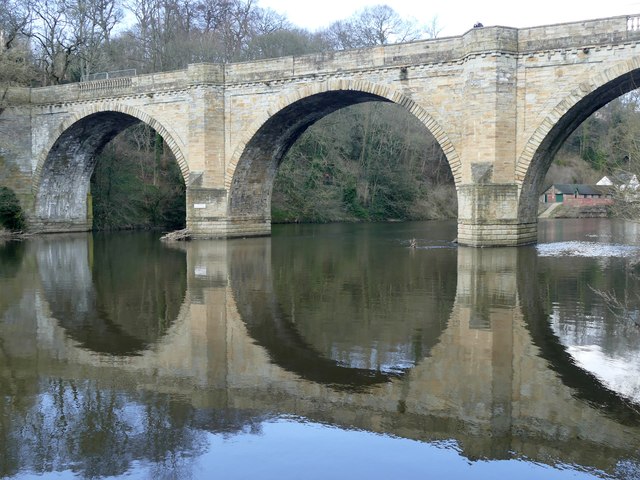
Prebends Bridge, Durham

Saddler Street, Durham

Silver Street, Durham

South Bailey, Durham

South Street, Durham

The College (street), Durham

WW1 Memorial Cross, Durham Cathedral


